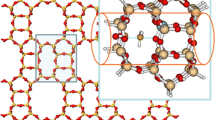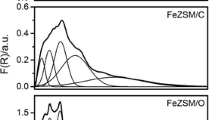Abstract
Molecular-level understanding of the interactions between reactants and the surface of solid catalysts is of importance to the rational design of catalysts. Here, in situ transmission Fourier transform infrared spectroscopy is employed to investigate the ion exchange between the acidic hydrogen in organic molecules that have been adsorbed from the gas phase and sodium cations in zeolites. Organic compounds with functional groups common among key biomass-derived compounds are used as probe molecules. We demonstrate that ion exchange between acidic hydrogen in organic molecules and the sodium cations in zeolites with the FAU topology produces Brønsted acid sites and the corresponding adsorbed salt species by identifying signature spectroscopic bands. Furthermore, the gas-phase deprotonation enthalpy (GPDE) of the organic compounds is identified as a key descriptor in determining the feasibility and extent of the exchange process. Molecules with GPDE below 1462 kJ/mol, e.g., m-cresol (1462 kJ/mol), propanoic acid (1454), acetic acid (1457), acrylic acid (1440) and trifluoroacetic acid (1357), show clear vibrational bands for Brønsted acid sites and the corresponding sodium salts, while molecules with higher GPDE, such as trifluoroethanol (1513), ethanol (1586), and water (1622) do not. These data indicate that the degree of dissociation of the acidic hydrogen is a key element in the ion exchange. The generality of this process in zeolites is established by the observation of similar results on zeolites with differing topologies (FAU, MFI, *BEA, and MOR).














Similar content being viewed by others
References
Dusselier M, Van Wouwe P, Dewaele A, Makshina E, Sels BF (2013) Energy Environ Sci 6:1415–1442
Dusselier M, Sels BF (2014) Top Curr Chem 353:85–125
T. Werpy, G. Peterson, P.N.N.L., N.R.E.L., E.E.R.E (2004)
Alonso DM, Bond JQ, Dumesic JA (2010) Green Chem 12:1493–1513
Bruijnincx PCA, Weckhuysen BM (1987) Angew Chem Int Ed 52(2013):11980–11981
Stocker M (2005) Microporous Mesoporous Mater 82:257–292
Jacobs PA, Dusselier M, Sels BF (2014) Angew Chem Int Ed 53:8621–8626
Ogura M, Shinomiya SY, Tateno J, Nara Y, Nomura M, Kikuchi E, Matsukata M (2001) Appl Catal A 219:33–43
Sun P, Yu DH, Fu KM, Gu MY, Wang Y, Huang H, Ying HH (2009) Cat Commun 10:1345–1349
Sun P, Yu DH, Tang ZC, Li H, Huang H (2010) Ind Eng Chem Res 49:9082–9087
Yan J, Yu DH, Sun P, Huang H (2011) Chin J Catal 32:405–411
Zhang JF, Zhao YL, Pan M, Feng XZ, Ji WJ, Au CT (2011) ACS Catal 1:32–41
Yan B, Tao LZ, Liang Y, Xu BQ (2014) ChemSusChem 7:1568–1578
Katryniok B, Paul S, Dumeignil F (2010) Green Chem 12:1910–1913
Wu W, Weitz E (2014) Appl Surf Sci 316:405–416
Jentys A, Lercher JA (2001) In: van Bekkum H, Flanigen EM, Jacobs PA, Jansen JC (eds) Introduction to zeolite science and practice, 2nd edn. Elsevier, Amsterdam
Karge HG, Ziolek M, Laniecki M (1987) Zeolites 7:197–202
Treacy MMJ, Higgins JB (2001) Collection of simulated XRD powder patterns for zeolites. Elsevier, New York
Cejka J, van Bekkum H, Corma A, Schüth F (2007) Introduction to zeolite science and practice, 3rd edn. Elsevier, New York
Yang C, Wang J, Xu QH (1997) Microporous Mater 11:261–268
Ward JW (1968) J Catal 11:238–250
Selvam T, Bandarapu B, Mabande GTP, Toufar H, Schwieger W (2003) Microporous Mesoporous Mater 64:41–50
Camblor MA, Corma A, Valencia S (1998) Microporous Mesoporous Mater 25:59–74
Emeis CA (1993) J Catal 141:347–354
Weltner W (1955) J Am Chem Soc 77:3941–3950
Phung TK, Carnasciali MM, Finocchio E, Busca G (2014) Appl Catal A 470:72–80
Tam MS, Gunter GC, Craciun R, Miller DJ, Jackson JE (1997) Ind Eng Chem Res 36:3505–3512
Spivey JJ, Roberts GW, Davis BH (2001) Catalyst deactivation 2001. In: Proceedings of the 9th International Symposium, Elsevier: New York
Stein SE NIST chemistry WebBook, NIST Standard Reference Database Number 69. In: Linstrom PJ, Mallard WG (eds), National Institute of Standards and Technology: Gaithersburg, pp 20899
Natal-Santiago MA, Dumesic JA (1998) Microcalorimetric. J Catal 175:252–268
Krishnakumar V, Kumar M, Prabavathi N, Mathammal R (2012) Spectrochim. Acta Part A 97:144–154
Jakobsen RJ (1965) Spectrochim Acta 21:433–442
Jakobsen RJ (1971) J Mol Struct 10:300–303
Feairheller W, Katon JE (1967) Spectrochim. Acta Part A 23:2225–2232
Regis A, Corset J (1975) Chem Phys Lett 32:462–465
Sun GH, Sun XT, Sun ZH, Wang XQ, Liu XJ, Zhang GH, Xu D (2009) J Cryst Growth 311:3904–3910
Redington RJ (1975) Spectrochim. Acta Part A 31:1699–1705
Zholobenko VL, Makarova MA, Dwyer J (1993) J Phys Chem 97:5962–5964
Xu B, Bhawe Y, Davis M (2012) Proc Natl Acad Sci 109:9260–9264
Xu B, Bhawe Y, Davis M (2013) Chem Mater 25:1564–1571
Acknowledgments
We acknowledge support from the Catalysis Center for Energy Innovation, an Energy Frontier Research Center funded by the U.S. Department of Energy, Office of Science, Office of Basic Energy Sciences under Award No. DE-SC0001004. BX and MED acknowledge that preliminary results of this work were obtained at Caltech with financial support provided by a donation from Mr. and Mrs. Lewis W. F Amerongen. The authors would also like to acknowledge Dr. Sonjong Hwang at the California Institute of Technology for his assistance in performing the 29Si solid-state NMR measurements.
Author information
Authors and Affiliations
Corresponding author
Additional information
This article is dedicated to Prof. Mark E. Davis, the recipient of the prestigious Gabor A. Somorjai Award for Creative Research in Catalysis. Mark’s pioneering work in the synthesis of zeolites with novel structures and unprecedented control of catalytic sites has to a significant extent shaped the field of microporous materials and profoundly influenced both academic and industrial researchers in heterogeneous catalysis on the rational design of solid acid catalysts. Aside from his achievements in heterogeneous catalysis, Mark’s creativity has also benefited several other fields, such as cancer therapy and thermochemical cycles. During my postdoctoral stay in his group (2011–2013), we developed a low temperature manganese-oxide based thermochemical cycle for water splitting [39, 40], a topic Mark explored very early on in his academic career. Another key aspect of Mark’s contribution to the scientific community in general is via mentoring and inspiring students and junior researchers around him to take on important scientific challenges in a rational and creative manner, from which I benefited enormously. In this contribution, we show that gas-phase deprotonation enthalpy of organic molecules adsorbed from gas phase on sodium exchange zeolites is a reliable predictor for the ion exchange reaction, creating in situ generated Brønsted acid sites. Some preliminary experiments for this work were conducted in Mark’s lab at Caltech towards the end of my stay. Finally, I would like to congratulate Mark for receiving this prestigious and well-deserved award.
Rights and permissions
About this article
Cite this article
Murphy, B., Davis, M.E. & Xu, B. The Effect of Adsorbed Molecule Gas-Phase Deprotonation Enthalpy on Ion Exchange in Sodium Exchanged Zeolites: An In Situ FTIR Investigation. Top Catal 58, 393–404 (2015). https://doi.org/10.1007/s11244-015-0383-z
Published:
Issue Date:
DOI: https://doi.org/10.1007/s11244-015-0383-z




